Mechanism questions
(using the Marvin JS chemical editor)
Updated 19 Feb 2024
Some Mastering questions include tools for drawing organic mechanism boxes, reaction arrows, and curved arrows to indicate electron flow using the Marvin JS chemical drawing tool.
Marvin JS is an advanced chemical editor from ChemAxon, Ltd that's used in pharmaceutical and other industries. Complete Marvin JS mechanism questions on a computer, not on a smartphone.
 Watch a video: Answer chemical drawing questions
Watch a video: Answer chemical drawing questions
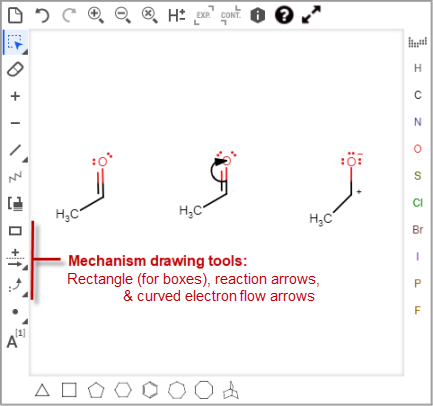
When available, open the Introduction to Mastering assignment and select the Introduction to Organic Mechanisms item. The tutorial contains instructions, videos, hints, and practice questions for you to answer using Marvin JS. This assignment provides practice items for different kinds of questions.
You can usually return to this assignment anytime during the course, even after its due date. If you completed this assignment, you can usually rework its items for practice.
Ease-of-use features
- Play videos about how to draw in Marvin —
Select Drawing Help from the top toolbar and then choose How-to Video Tours.
Drawing Help from the top toolbar and then choose How-to Video Tours. - View the name or purpose of a button —
Point to a button. - Zoom in on structures on the canvas —
Choose the Zoom in or
Zoom in or  Zoom all (for maximum size) from the top toolbar. You can also access Zoom all from the right-click menu. Scroll bars become active if the structure is larger than the canvas.
Zoom all (for maximum size) from the top toolbar. You can also access Zoom all from the right-click menu. Scroll bars become active if the structure is larger than the canvas. - If you accidentally delete drawn elements that are provided to you on the canvas, be sure to choose
 Undo right away.
Undo right away.
Drawing features
- Identify atoms by "mapping" them to a number —
Select Atom map from the left toolbar. See next section for how to map/unmap atoms.
Atom map from the left toolbar. See next section for how to map/unmap atoms. - Set or edit charges and radicals —
Select options from the left toolbar. See next section for details about charges and radicals.To show more bonds or the drawing tool for mechanism drawing — Point in the lower right corner of the active bond button (left menu). For 3D drawing, bonds appear on the left toolbar.
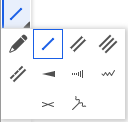
- Any valence errors are highlighted in red for you to correct. This option may not be available for all questions.
- Add or remove explicit H atoms —
Choose
 Add/Remove explicit H button from the top toolbar.
Add/Remove explicit H button from the top toolbar. - To draw more quickly, choose any of the following options.
 Drawing tool from the bonds menu (left toolbar).
Drawing tool from the bonds menu (left toolbar).
Ctrl+D for Windows and Command-D for Mac also activates the drawing tool.-
 Chain tool or
Chain tool or  Abbreviated groups from the left toolbar
Abbreviated groups from the left toolbar - Select a template from the bottom toolbar, like for
 Benzyne.
Benzyne.
To draw in a larger window —
Choose  Expand from the top toolbar. When you finish drawing, choose Return this drawing to the main window.
Expand from the top toolbar. When you finish drawing, choose Return this drawing to the main window.
|
|
From the Atoms toolbar (on the right):
From your keyboard: Place your pointer on the canvas and type the symbol for the atom from your keyboard, such as N for nitrogen. To get out of atom mode: Select another mode. For example, select a bond or charge.
You "map" (identify) atoms in your answer by labeling them with a number. Map an atom:
To increase a map number — Point to the atom and click again. Edit or unmap an atom:
When you place a non-metallic atom on the canvas, it may be automatically completed with implicit hydrogens according to the free valences of the atom. For example, instead of C, you might see CH4. This behavior can vary from question to question.
|
|
|
Choose When available, the drawing tool lets you create a framework of bonds without releasing your pointer. Add each bond by dragging your cursor towards a provided a gray dot. Toolbar:Expand the bonds menu from the left toolbar (by pointing in the lower right corner of the active bond). Then, choose the
Keyboard shortcut for the Drawing tool: Ctrl+D (Windows) or Command-D (Mac OS) |
|
Charges and Radicals |
Select
|
Once you select a box, you can move or rotate it like any other object in the canvas.
|
|
|
Electron flow arrows should start on the electrons of an atom or a bond and should end on an atom, bond, or location where a new bond should be created. You can draw an electron flow arrow from the electrons of an atom so that its arrowhead lands either in the space between atoms or on an established bond. Marvin also lets you place electron flow arrows on an atom when a new bond is forming. However, Mastering may not always be able to interpret the atoms intended to form the new bond. To ensure the proper atoms are forming the new bond: Look for a dotted line connecting the atoms. When the electron flow arrow is active, select a curved arrow to rotate through possible interactions.
Drag the arrow while either the electron flow arrow or a selection button ( |
|
|
|
|
Abbreviated groups (Superatom or S-groups) |
Marvin provides a selection of abbreviated groups. You can make an abbreviated group part of a larger molecule by connecting the group to other fragments through an attachment point.
|
|
Absolute stereo (chiral) |
Right-click on an empty spot on the canvas and choose Absolute stereo (chiral). (Mac users: Use an equivalent for right-clicking.) A check mark appears next to the Absolute stereo (chiral) option to indicate that this has been set. This setting indicates that the molecule represents a single, well-defined stereoisomer. Right-click on the canvas and choose Absolute stereo chiral to remove its check mark. Mac users: Use the equivalent for right-clicking. |
|
|
Templates can save you drawing time. Select a template button and then place the template on the canvas. (The templates provided for mechanism questions are the same as those for 2D drawing.) Point to a template button for its name to display online. Cyclopropane Cyclobutane Cyclopentane Cyclohexane Benzene Cycloheptane Cyclooctane Bicyclo[2.2.2]octane |
|
Undo/Redo |
|
|
|
Point to the item on the canvas (a green highlight appears), and then select it.
Point on the canvas outside of the selected object(s). Important: When asked to identify atoms for an answer, you must use atom mapping. Just selecting atoms is not enough for the system to interpret or grade as an answer. |
|
Delete |
Important: If you accidentally delete provided elements, select
Important: Do not use these commands if elements have been provided for the question! Toolbar: Select Keyboard: Press Ctrl+Delete (Windows) or Command-Delete (Mac OS). |
|
With one of the selection tools active (
Moving the center point allows you to rotate a molecule around any point on the canvas.
|
See also: Marvin JS User's Guide
This searchable guide on the ChemAxon website includes the latest info about Marvin, including some features that are NOT applicable to Mastering
assignments.
 Periodic table and then select an atom.
Periodic table and then select an atom.

!["OH molecule mapped as [1] and CH3 mapped as [2]"](../Resources/ImagesStudent/marvin_chem/marvin_mapped_atoms.png)
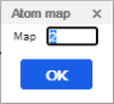
 = Drawing
= Drawing = Single [1]*
= Single [1]* = Double [2]
= Double [2] = Triple [3]
= Triple [3] = Aromatic [4]
= Aromatic [4] = Single up [5] (wedge)*
= Single up [5] (wedge)* = Single down [6] (dashed)*
= Single down [6] (dashed)* = Single up or down
= Single up or down = Double cis or trans
= Double cis or trans = R-Group attachment
= R-Group attachment Increase charge or
Increase charge or  Decrease charge (left toolbar), and then click the atom on the canvas.
Decrease charge (left toolbar), and then click the atom on the canvas. Increase radical (left toolbar) and accept
Increase radical (left toolbar) and accept  Increase radical or
Increase radical or  Increase lone pair.
Increase lone pair. Rectangle (left toolbar).
Rectangle (left toolbar).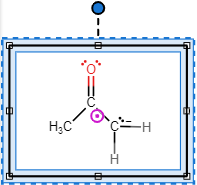
 Electron flow double arrow (also known as double harpoon or curved arrow) or
Electron flow double arrow (also known as double harpoon or curved arrow) or  Electron flow single arrow (also known as single harpoon) from the left toolbar.
Electron flow single arrow (also known as single harpoon) from the left toolbar. Rectangle selection or
Rectangle selection or  Freehand selection) is active on the toolbar.
Freehand selection) is active on the toolbar. Straight arrow / Reaction or the
Straight arrow / Reaction or the  Two-headed arrow / Reaction from the toolbar.
Two-headed arrow / Reaction from the toolbar.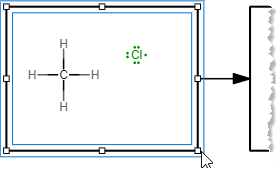
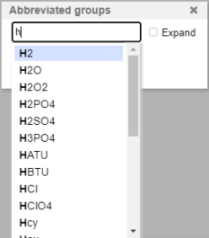
 Expand group abbreviation
Expand group abbreviation Contract to group abbreviation
Contract to group abbreviation






 Rectangle selection or
Rectangle selection or  Freehand selection (left toolbar).
Freehand selection (left toolbar).  Delete (left toolbar) and then point on each object you want to delete.
Delete (left toolbar) and then point on each object you want to delete.  Clear (upper left corner).
Clear (upper left corner). 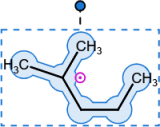
 Zoom Out from the top toolbar.
Zoom Out from the top toolbar.